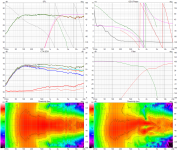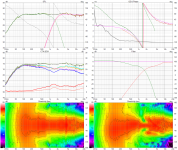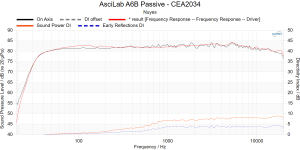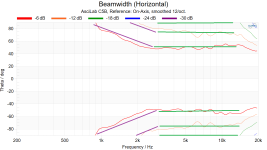Because STL files don't contain units and it was made for inches and not mm. Most STL viewers default to mm.
Ok, so easy fix scale by 2540. Thanks, I wonder why it doesn't understand scaling (AnkerMake Slicer) it reads mm SketchUp files perfectly.
With the nicely designed files from Somasonus, are you printing them face down, as the driver mount has sticking out reference pins?
With the nicely designed files from Somasonus, are you printing them face down, as the driver mount has sticking out reference pins?
Most programs expect mm so files made in imperials units are not universal.Ok, so easy fix scale by 2540. Thanks, I wonder why it doesn't understand scaling (AnkerMake Slicer) it reads mm SketchUp files perfectly.
No that is the worst orientation to print. You can print them upright with support under the bottom edge or face up with a support bed. There are pros and cons to both options.With the nicely designed files from Somasonus, are you printing them face down, as the driver mount has sticking out reference pins?
Sorry for the nob question..but
A waveguide change the crossover response?
Let's said I want to add a waveguide to a design that's already made and in the original version is not used or include in the design calculation...the waveguide change the response in another way than directivity?
Thanks
A waveguide change the crossover response?
Let's said I want to add a waveguide to a design that's already made and in the original version is not used or include in the design calculation...the waveguide change the response in another way than directivity?
Thanks
Yes, it usually reduces radiation angle for lower frequencies (where tweeters have a wide radiation angle) and thus increases on-axis output for these frequencies.the waveguide change the response in another way than directivity?
Have a look:
http://www.zaphaudio.com/hornconversion.html
Thanks.
I understand on zapj site that change the response..as you said in increase the response
I understand on zapj site that change the response..as you said in increase the response
Friend is currently printing the 6.5" round waveguide (SB ADC one) for me. He has one almost done but did comment on the weird lack of or misrepresentation of dimensions. He wanted to get some confirmation on the sizing of the first print before starting the second.
Does anyone have any dimensions for that waveguide so we can confirm it came out correctly? My friend has stated he landed at an outer diameter of 7.5"
Any help here would be much appreciated.
Does anyone have any dimensions for that waveguide so we can confirm it came out correctly? My friend has stated he landed at an outer diameter of 7.5"
Any help here would be much appreciated.
The 6" is probably a better match to whatever woofer your friend is using.
He's just the man with the printer, I'm the speaker guy. I was considering pairing it with a 5.25" woofer.
It is usually easier to get a nice smooth DI match between woofer and waveguide when the waveguide's effective size is smaller than the woofers effective diameter. When they are the same size or the waveguide is bigger there will be a DI bump from there being too much directivity in the combination. The only time it really works easily to have them the same size is when you want to keep the directivity as high as possible as low as possible. Like in a 90 degree horn with a 15" woofer.
The woofer choice is not set in stone, it really comes down to how the options I have disperse in a box. Most of the 6.5" drivers I've used seem to go kind of narrow earlier than I would expect, I was hoping a smaller woofer would keep things a bit wider in the region of the xover point. If that doesn't pan out, I'm not opposed to say an 8" woofer.
Can you describe the DI bump in maybe more visual detail? Or another way, I'm not sure what bump translates to here.
A similar speaker to my smaller woofer combo would be the ascii labs c5b, it appears to use a waveguide larger than the woofer. Worth considering the low xover point and different waveguide.
https://www.audiosciencereview.com/forum/index.php?threads/ascilab-c5b-review.58753/
Can you describe the DI bump in maybe more visual detail? Or another way, I'm not sure what bump translates to here.
A similar speaker to my smaller woofer combo would be the ascii labs c5b, it appears to use a waveguide larger than the woofer. Worth considering the low xover point and different waveguide.
https://www.audiosciencereview.com/forum/index.php?threads/ascilab-c5b-review.58753/
The ascii speaker linked shows exactly what a waveguide bigger than the driver does. The DI is held as high as possible for as low as possible before it then drops as the woofer becomes less directional. There will be a natural frequency between the woofer in the box and tweeter in the waveguide where this can work. The way they have tuned the speaker is to have a flatish on axis, which above the crossover results in flat output across a lot of angles due to the flat DI. The woofer cannot match this naturally so there is a bend up in the off axis responses as the DI begins to lower. I don't see a predicted in room in the link but it would be very much like the early reflections curve and similar to KEF's R3, downsloping then flattening out as the waveguide DI flattens. If this is what you want in the design or fits your preference in sound then that is how to get it.
If you would prefer a smoothly rising DI so that the in room and power is a smooth downslope with no bends or bumps then you need to blend the directivities of the woofer and tweeter and the tweeter waveguide needs to have a rising directivity that matches with the upward rise of the woofer.
If you do not pick the right crossover frequency and use a typical in phase LR4 crossover the DI of the woofer and waveguide will combine to produce a bump in the DI at the crossover frequency with a corresponding dip in the power response.
I have attached two crossover versions of the same speaker. This is a speaker that has the waveguide the same size as the woofer, my own version of something similar to Purifi's SPK16. The one with the bump in DI at 1500Hz uses an in phase LR4 at 1500Hz, the one without the bump has a 2K crossover that doesn't quite conform to any partiular named slope. The one with the bump is obviously not good but is a demonstration of what not to do when both drivers have the same DI at the crossover point.
I chose in this version to slope the on axis down to get a smoothly falling in room response. If I made the on axis flat it would be like the ascii lab as they both have flat DI waveguides. This is a choice and whether one is better than the other is down to the preference of the listener for their use case.
If you would prefer a smoothly rising DI so that the in room and power is a smooth downslope with no bends or bumps then you need to blend the directivities of the woofer and tweeter and the tweeter waveguide needs to have a rising directivity that matches with the upward rise of the woofer.
If you do not pick the right crossover frequency and use a typical in phase LR4 crossover the DI of the woofer and waveguide will combine to produce a bump in the DI at the crossover frequency with a corresponding dip in the power response.
I have attached two crossover versions of the same speaker. This is a speaker that has the waveguide the same size as the woofer, my own version of something similar to Purifi's SPK16. The one with the bump in DI at 1500Hz uses an in phase LR4 at 1500Hz, the one without the bump has a 2K crossover that doesn't quite conform to any partiular named slope. The one with the bump is obviously not good but is a demonstration of what not to do when both drivers have the same DI at the crossover point.
I chose in this version to slope the on axis down to get a smoothly falling in room response. If I made the on axis flat it would be like the ascii lab as they both have flat DI waveguides. This is a choice and whether one is better than the other is down to the preference of the listener for their use case.
Attachments
If you do not pick the right crossover frequency
The goal is to obviously pick the right xover frequency...
The ascii speaker linked shows exactly what a waveguide bigger than the driver does.
I'm not seeing how the ascii lab shows any similarities to your sims. The DI is on the fourth graph and doesn't at all resembled the DI narrowing in your sim. If this is the bump you're describing I'm not seeing it on the ascii lab.
downsloping then flattening out as the waveguide DI flattens
Looking at some of my favorite speakers like behringer 2030p or genelec 8030c, this is how they perform I believe. The behringer is still my favorite sounding tweeter, and when that new 104mm purifi tweeter comes out I am buying two because I don't understand why no one else can make a tweeter that stays consistent and wide through it's entire passband with low distortion. I intend to use this 6.5" waveguide two way to replace some Amiga towers that I have grown very tired of. Not exactly a tough speaker to beat lol.
I'm sorry that the explanations haven't been helpful. I am already regretting the time I spent making the previous posts, I don't have the patience or interest to continue.
Once again I am presented with a feeling of "why do I come here" induced by a user being weird.
Fluid, not quoting you to get your attention, just to break down your statements and match up to the graphs (to what I think you are saying).
Note directivity mismatch around 1kHz (crossover point is ~1kHz)




The ascii speaker linked shows exactly what a waveguide bigger than the driver does. The DI is held as high as possible for as low as possible before it then drops as the woofer becomes less directional.
Note directivity mismatch around 1kHz (crossover point is ~1kHz)
...The way they have tuned the speaker is to have a flattish on axis, which above the crossover results in flat output across a lot of angles due to the flat DI. The woofer cannot match this naturally so there is a bend up in the off axis responses as the DI begins to lower. ...If this is what you want in the design or fits your preference in sound then that is how to get it.
If you would prefer a smoothly rising DI so that the in room and power is a smooth downslope with no bends or bumps then you need to blend the directivities of the woofer and tweeter and the tweeter waveguide needs to have a rising directivity that matches with the upward rise of the woofer.
I'm not seeing how the ascii lab shows any similarities to your sims. ..
....The one with the bump is obviously not good but is a demonstration
Looking at some of my favorite speakers ...this is how they perform I believe.
This is a choice and whether one is better than the other is down to the preference of the listener for their use case.
Attachments
Thank you for clarifying. That's honestly the dispersion pattern I was already expecting so I am not too bothered by that. I am not opposed to upping the woofer size however.
I wanted to find a review of the Behringer to see the measurements and found a quote from someone in 2021 (active version) "the Behringer 2030 is the widest active monitor I know about, and it certainly sounds that way. With a bit of EQ and a sub it's probably one of my favorite speakers."Looking at some of my favorite speakers like behringer 2030p or genelec 8030c, this is how they perform I believe. The Behringer is still my favorite sounding tweeter,
And the measurements look very similar to the Ascilab speaker, so I would expect you'd like the Ascilab or things similar.
- Home
- Loudspeakers
- Multi-Way
- Open source Waveguides for CNC & 3D printing!



